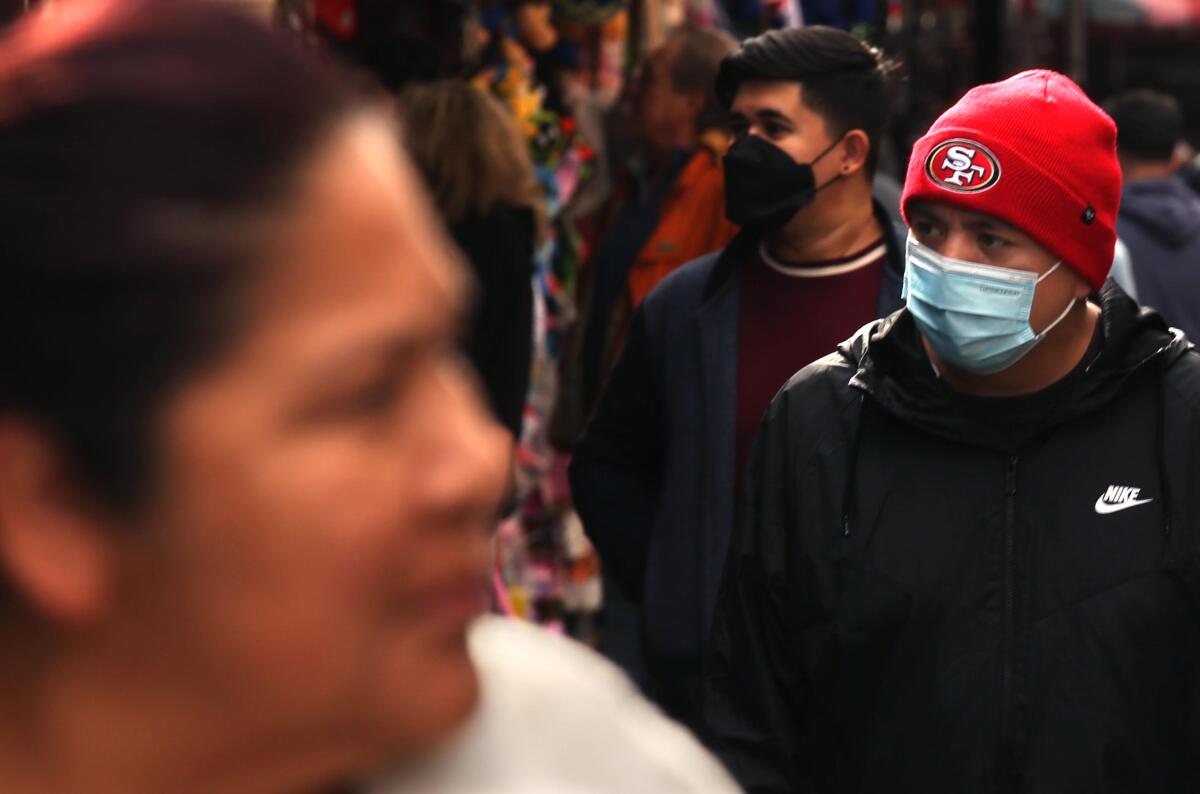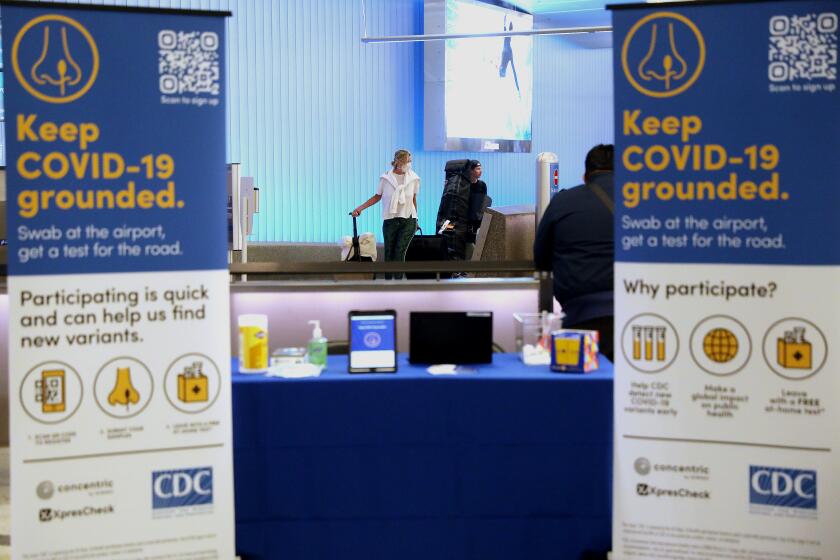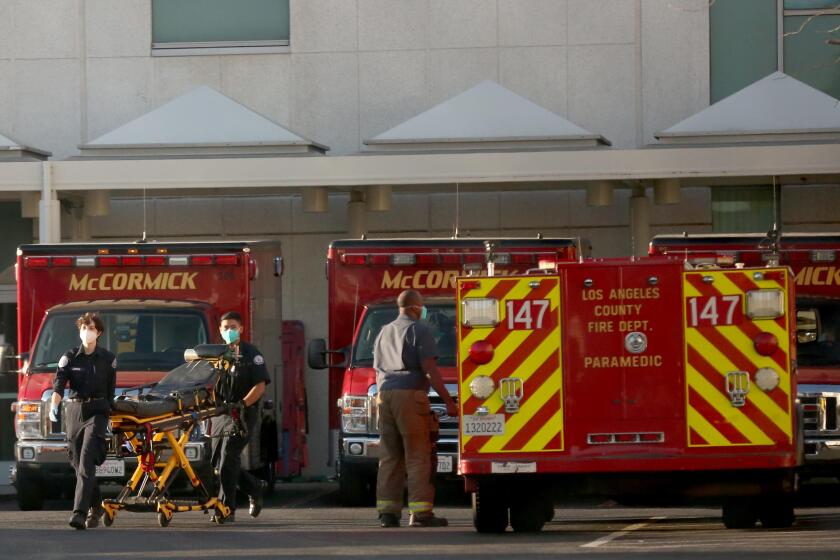California tops 12 million coronavirus cases as XBB.1.5 becomes dominant

The total number of coronavirus cases reported in California has topped 12 million.
That milestone â reached last week, according to data compiled by The Times â comes as California is seeing increased circulation of the Omicron subvariant XBB.1.5, which has been described as perhaps the most infectious strain of the coronavirus.
But in many respects, the pandemic picture remains relatively rosy, with newly reported infections declining and stabilizing in recent weeks. Hospitalizations have also ticked down to levels not seen since mid-November, indicating less strain on the healthcare system.
âWe do have more tools now than weâve had at any point during the pandemic,â Los Angeles County Public Health Director Barbara Ferrer told reporters. âWhile new strains always have the potential to drive surges in cases, to date, weâve not seen a major increase in cases associated with XBB.1.5.â
The statewide tally â just under 12.02 million cases as of Friday, according to The Timesâ tracker â is undoubtedly an undercount, because of both limited access to testing in the pandemicâs early days and the fact that many people now self-diagnose using at-home tests.
Even so, the figure constitutes a population larger than that of all but six states.
Modeling from the California Department of Public Health estimates that the spread of COVID-19 is probably decreasing statewide and has been for more than a month.
Still, the coronavirus has thrown its share of curveballs during the last three years. The latest is XBB.1.5, a member of the sprawling family of Omicron subvariants that have been dominant in the U.S. for months.
Transitioning out of the COVID emergency phase could eventually spell the end of universal access to free vaccines, treatments and tests.
That strain accounted for an estimated 74.7% of cases over the last week, according to the U.S. Centers for Disease Control and Prevention.
Its rise has been slower in California, Nevada, Arizona, Hawaii and the Pacific islands. But even in that Western region, XBB.1.5 accounts for an estimated 56.9% of new cases.
Despite its infectiousness, XBB.1.5 has not spawned a major spike in hospitalizations â sparking optimism that it may not be the beastly âKrakenâ some had feared.
âOutside the Northeast region during XBB.1.5âs rise, there was no surge in hospitalizations,â Dr. Eric Topol, director of the Scripps Research Translational Institute in La Jolla, tweeted Friday.
Unvaccinated people were more than seven times as likely to die from COVID-19 in Los Angeles County as those who received an updated booster during the latest coronavirus spike.
In California, the number of coronavirus-positive patients hospitalized Thursday was 2,485. Thatâs down markedly from this winterâs high of more than 4,600.
This is the first year that California did not experience a devastating surge coinciding with winter, a development many officials attribute to the widespread administration of vaccines.
âReal-world evidence continues to show that the vaccine prevents severe illness, hospitalization and death,â the California Department of Public Health said in a statement Thursday. âPublic health officials urge Californians to get vaccinated and boosted as soon as they are eligible.â
A preliminary study in Israel finds that seniors who received an Omicron-targeting booster shot were 81% less likely to be hospitalized with COVID-19 than those who skipped it.
According to the department, unvaccinated Californians were 2.4 times more likely to contract COVID-19 in December than those who had received at least their primary vaccine series. The unvaccinated were also 2.6 times more likely to be hospitalized and three times more likely to die from the disease.
The comparatively mild winter resurrected discussion of the once-hot topic of herd immunity â the point at which so many people are immune to a virus that it has difficulty finding new hosts to infect. While thousands of new cases are being reported each day in California, many individuals enjoy some protection through vaccination, prior infection or a combination of the two, experts say.
âWe donât really talk about herd immunity anymore. What weâve learned about this virus is that it continues to change and mutate, and itâs sort of a dance between the immunity in the population and what the virus is doing â and itâs a continual change. Itâs dynamic,â Dr. Sara Cody, Santa Clara Countyâs public health director and health officer, said during a news conference last week.
The way to think about it is âyouâre more protected if youâre vaccinated,â she said. âYouâre less protected if youâve never been vaccinated or itâs been a long time since youâve been vaccinated, and thatâs when you need to add some extra layers.â
Most health plans regulated by the California Department of Managed Health Care will be required to continue paying for at-home COVID test kits.
Aside from vaccination, Californians should mask up in indoor public settings, particularly among crowds, health officials say. Other familiar recommendations include practicing good hand hygiene, covering your mouth and nose when you cough or sneeze, staying home when youâre sick, testing if you suspect youâve been exposed to the coronavirus and promptly seeking treatment if infected.
Those resources have helped forge what officials characterize as a new phase of the pandemic, one marked by careful preparation. Gov. Gavin Newsom has announced that the COVID-19 state of emergency in California will end Feb. 28, and the federal national emergency and public health emergency declarations will terminate May 11.
âItâs important to acknowledge that the changes weâre seeing are a testament to the way residents have adapted, learned and continue to use the new tools and commonsense protections when warranted,â Ferrer said. âOver the next few months, as emergency orders lift and new proposals are put into play, there will be a lot of information circulating. Letâs not let go of what weâve learned so far so that we can take advantage of the protections that are available.â
Most of all, she added, âbecause COVID will continue to impact people long after itâs left the spotlight, letâs continue to care for each other.â
Times staff writer Sean Greene contributed to this report.
More to Read
Sign up for Essential California
The most important California stories and recommendations in your inbox every morning.
You may occasionally receive promotional content from the Los Angeles Times.















